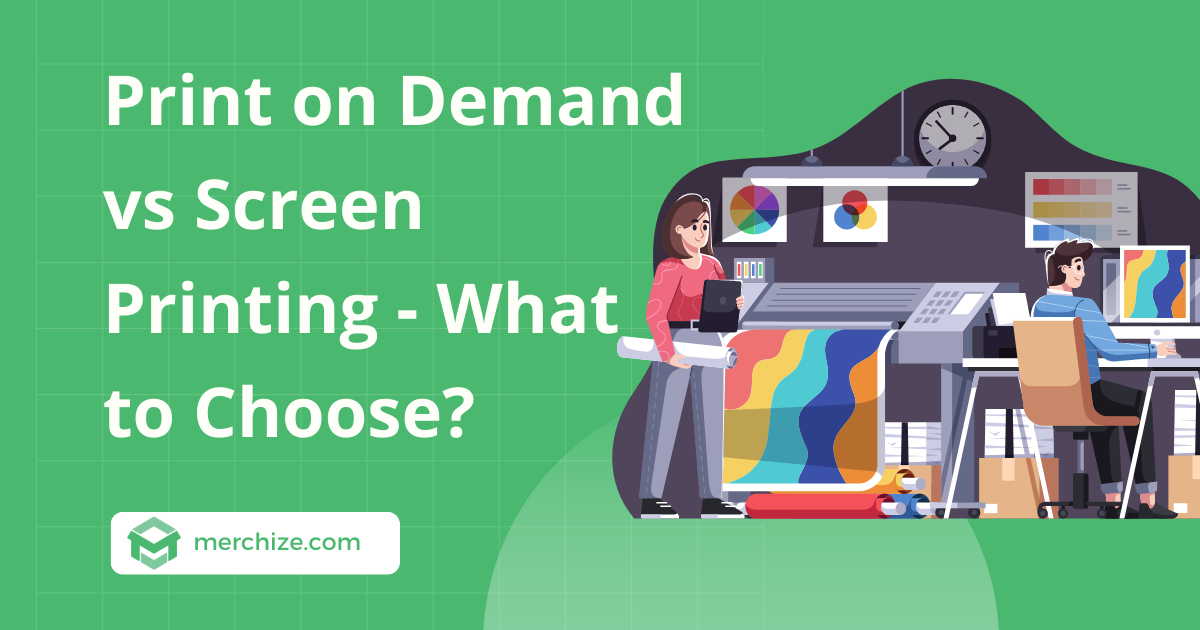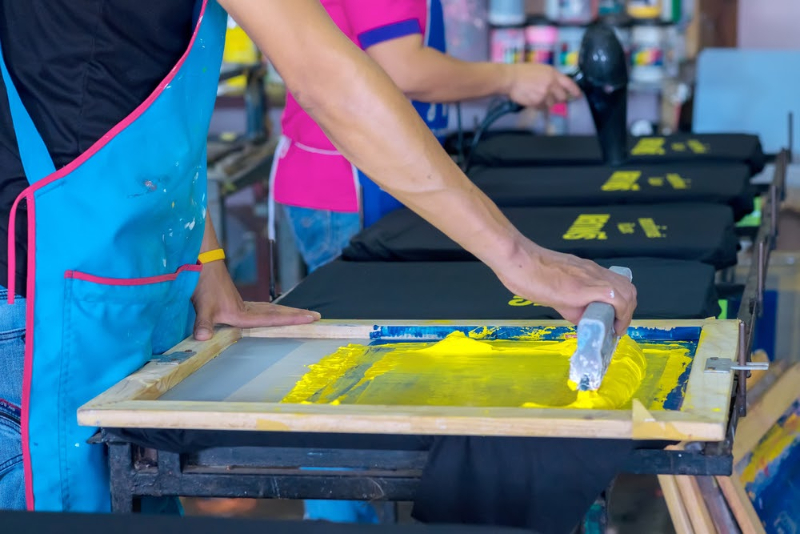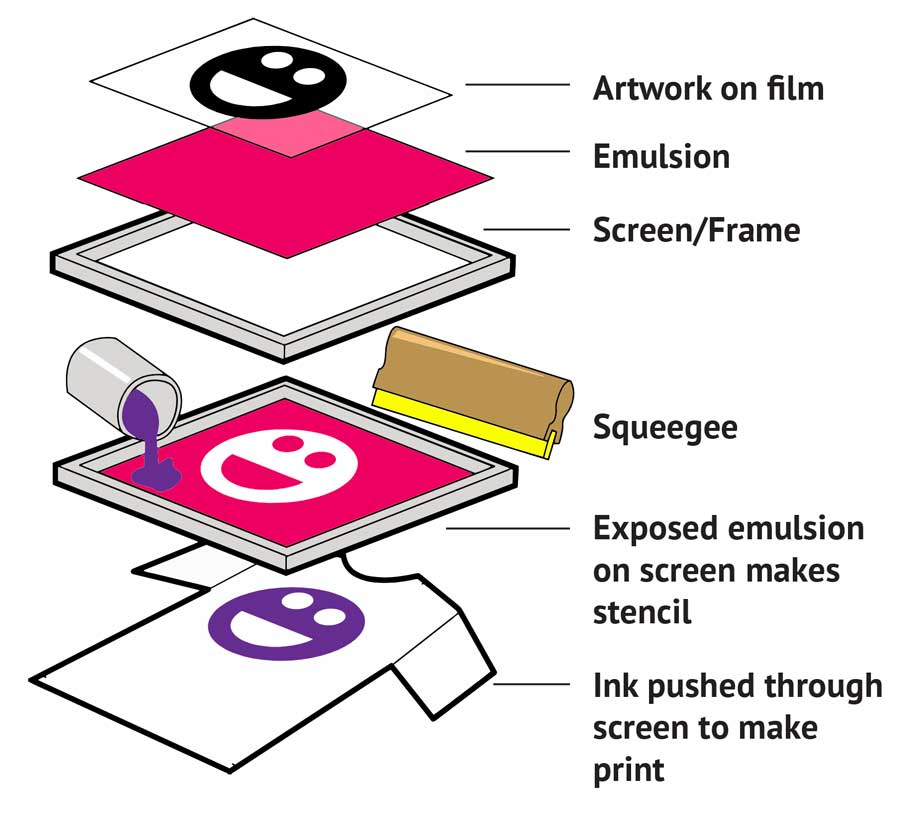Contents
Print on demand and screen printing are two distinctive concepts that are frequently mentioned in the world of printing. However, for a newbie, it might be confusing to navigate into this sphere and make sense of every single term and concept. In this article, we will explain in detail the definition, pros and cons of both print on demand and screen printing, and what makes them different from each other.
What is print on demand?
Print on demand is a business model that allows the sellers to sell custom goods without owning the inventory. Instead, sellers will work with a third-party partner who takes care of the production, packaging, and shipping. Products are only printed after an order is received.
With print on demand, sellers have the opportunity to work with a wide variety of products, from apparel to decoration products. During the manufacturing process, print on demand partners can use various printing methods, including Direct-to-garment, UV printing, dye sublimation, and so on.
What is screen printing?
While print on demand indicates a specific business process, screen printing indicates a specific technical printing method.
This printing method involves creating a stencil (or a screen) and using it to apply layers of ink on the printing surface. Screen printing can be used to add print to various materials like fabric, paper, or glass.
How print on demand works
To help you better understand the concept of print on demand, we will walk you through a complete process of print on demand business and how it works.
Create designs and list your products: Before the production begins, you must create your own designs and have them listed on your website or marketplaces. By creating unique custom designs for your print on demand products, you can stand out from the crowd and attract more customers.
- Get orders: When your listings are ready, the next step is to execute your promotion plan, bring the right customers to your store, and encourage them to make purchases.
- Process orders: Upon receiving orders, you will have to transfer these order details to a print on demand provider of your choice. Some print on demand suppliers offer direct integration to your ecommerce store, which allows all orders to be automatically synchronized to their fulfillment system. Otherwise, you can manually send the details to your print on demand suppliers for orders to be processed.
- Print orders: After receiving order information from print on demand sellers, print on demand suppliers will start their production. The design will be printed on the products, finalized, and quality-checked before packed and sent to customers.
The production process can differ widely from product to product. Based on factors like materials or custom options, print on demand companies would avail different printing techniques. For example, for simple apparel products, they usually use the direct-to-garment method. For complicated all-over print designs, dye sublimation is usually the print technique of choice. Digital printing is usually preferred for printing on special materials like paper, wood, acrylics, and so on.
A customer places an order through an online store or marketplace. This order can include items like books, t-shirts, mugs, or posters.
4. Package orders: The completed product is carefully packaged to protect it during shipping. At Merchize, it is possible for sellers to add branded packaging and materials with our branding service.
5. Ship orders: The packaged product is shipped directly to the customer using the selected shipping method. Tracking information is provided to the customer.
6. After-sales support: After the products are delivered to customers, if any issues arise, print-on-demand sellers will have to provide customer support and handle the situation, possibly through returns or refunds.
How screen printing works
Compared to the complicated print on demand process that deals with all aspects of an online business, screen printing can be considered a small-scale process that only involves the printing alone.
- Create designs: Design creation is also the starting point of the screen printing process. With screen printing, a simple design with bold colors and elements is preferred over complex colorful designs. Gradient or photographic images are big nos.
- Prepare screens for printing: First of all, you must apply a layer of light-reactive emulsion onto the mesh screen and wait for the emulsion to dry.
- About your design, print it onto a transparent sheet and place this printed sheet on the emulsion-coated screen. Expose the screen under UV light for the emulsion to set. The print on the transparent sheet won’t let the light go through and activate the emulsion.
- As a result, in areas where the print covers, the emulsion won’t set and can be rinsed off easily with water. In no-emulsion areas, the ink isn’t blocked by the emulsion layer and can go through the mesh screen easily.
- Apply ink: Place the screen on the printing surface. Now, you can spread the ink across the screen with a squeegee. The ink will pass through the mesh screen and sit on the materials.
With the screen printing technique, each color layer requires a separate screen and alignment. The more colors a design has, the more screens and more layers of ink are needed.
After printing, the material needs to dry or cure to set the ink.
Pros and cons of print on demand
Before entering the print on demand business, many new sellers are wondering if print on demand is still profitable. The answer is Yes. Print on demand can deliver many advantages for a new starter in the world of e-commerce. Even when the competition is getting tougher every day, the appeal and possibilities that print on demand can deliver still overshadow all the drawbacks.
Pros of Print on Demand (POD):
- Low upfront Costs: No need to invest in large inventories. Products are created only when an order is placed.
- Minimal Waste: Reduces overproduction and waste, as items are printed to meet actual demand.
- Flexibility: Easy to test new designs or products without a large financial commitment.
- Inventory Management: Eliminates the need for storage space and managing stock.
- Customization: Allows for personalized or unique designs for each order, appealing to niche markets.
- Scalability: Can easily scale up or down based on demand without significant changes in operations.
Cons of Print on Demand (POD):
- Higher Unit Costs: Producing items one at a time can be more expensive per unit compared to bulk production.
- Limited Control: Reliance on third-party POD services may lead to variability in quality and shipping times.
- Longer Fulfillment Times: Printing and shipping times can be longer compared to having pre-made inventory.
- Quality Variations: Depending on the provider, there may be inconsistencies in print quality or material.
- Profit Margins: Higher production costs can lead to lower profit margins per item.
- Product Range Limitations: Some POD services may have a limited selection of products to choose from.
Pros and cons of Screen printing
Pros of screen printing
- High Quality and Durability: Produces vibrant, long-lasting prints that withstand washing and wear.
- Cost-Effective for Large Orders: Economical for bulk production due to low per-unit costs once setup is complete.
- Versatile on Various Materials: Works well on a wide range of materials, including fabric, paper, plastic, and metal.
- Color Vibrancy: Achieves rich, opaque colors, especially on dark backgrounds.
- Scalability: Efficient for producing large quantities of the same design.
Cons of Screen printing
- High Setup Costs: Requires creating a separate screen for each color, making it expensive for small orders or single prints.
- Limited Detail: Not ideal for designs with intricate details or a high level of complexity.
- Environmental Impact: Uses more ink and chemicals, potentially leading to higher waste and environmental concerns.
- Space and Equipment Requirements: Needs significant space for equipment and drying areas, as well as proper ventilation for handling inks and chemicals.
- Time-Consuming Setup: Preparing screens and aligning colors can be labor-intensive and time-consuming, slowing down the initial process.
Overall, screen printing is excellent for producing high-quality, durable prints in large quantities but may not be practical for small runs or designs requiring fine detail.
Why screen printing is not suitable for print on demand?
Screen printing is one of the oldest printing methods in the world and among the most popular printing techniques today. However, it is not widely applied in print on demand for a few reasons:
- Long setup time: With screen printing, each design requires a custom screen to be created, which takes time and effort. This setup process isn’t practical for single or small-batch orders like what print on demand usually offers. Even worse, it can extend the already long production time for print on demand orders.
- Cost efficiency: Screen printing is cost-effective for large printing volumes because the setup costs are spread over many items. For one-off orders, these costs make the process expensive.
- Inventory requirements: Screen printing usually involves printing a large number of items at once to be cost-effective, requiring storage space and inventory management, which goes against the no-inventory nature of print-on-demand.
- Flexibility: Print on demand often involves a high degree of customization, with unique designs for each order. Screen printing is less flexible for such variations due to the need for different screens for each design.
Print on demand thrives on the promise of a quick, convenient printing service with no inventory and no minimum quantity required. Screen printing couldn’t deliver the level of flexibility that print on demand requires. So most print on demand providers don’t use screen printing for printing orders. Instead, they prefer other options like direct-to-garment, dye sublimation, or UV printing.
If you compare screen printing with DTG, or screen printing with Sublimation, it is clear that both DTG and sublimation can offer more flexibility. This is also the major reason why DTG and Sublimation are more popular in print on demand than screen printing.
Who Should Use Print on Demand (POD)?
- Startups and small businesses: Ideal for businesses with limited capital that want to minimize upfront investment in inventory.
- E-commerce entrepreneurs: Beneficial for online stores that want to offer a diverse product range without managing physical stock.
- Artists and designers: Allows them to offer a wide range of customizable products without worrying about stock.
- Niche markets: Perfect for businesses targeting niche audiences with unique or personalized designs.
- Event planners and organizations: Useful for printing customized merchandise for events or special occasions on demand.
Who Should Use Screen Printing?
- Large Businesses and Manufacturers: Suitable for companies needing large quantities of printed items, as it is cost-effective for bulk orders.
- Sports Teams and Clubs: Ideal for producing team uniforms, jerseys, and club merchandise in high volumes.
- Promotional Product Suppliers: Great for creating promotional items like t-shirts, bags, and posters for marketing campaigns.
- Clothing Brands: Beneficial for fashion brands that require high-quality, durable prints for their apparel lines.
Navigating the world of printing can be daunting, but understanding the distinctions between print on demand and screen printing is a great start. Each method has its unique advantages and fits different needs. Now that you are familiar with the pros and cons of both, consider which aligns best with your business goals and start exploring the possibilities.
Whether you’re a budding entrepreneur, an artist, or managing a large-scale operation, taking the next step could transform your vision into reality. Get ready to take advantage ò these printing methods to bring your creative ideas to life.









